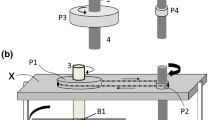Abstract
Permanent-magnet motors are suitable choice for special applications such as aircrafts, marine, and electric vehicles Because of the fault tolerance and high power density capability. In this paper, an analytical design of a five-phase permanent-magnet motor is done and the advantages of multi phase motor over three phase motor are studied. Next Finite-element method is applied to verify and validate different machine designs. Finally thermal analysis of the designed machines is done. The results are shown multi phase motor has lower cogging torque and operation temperature, higher electromagnetic torque and back-emf in comparison with three phase motor.














Similar content being viewed by others
References
Li G, Ren B, Zhu ZQ (2017) Design guidelines for fractional slot multi-phase modular permanent magnet machines. IET Electr Power Appl 11(6):1023–1031
EL-Refaie AM, Shah M, Alexander JP, Galitoto S, Huh K-K, Gerstler WD (2011) Rotor end losses in multi-phase fractional-slot concentrated-winding permanent magnet synchronous machines. IEEE Trans Ind Appl 47(5):2066–2074
EL-Refaie AM (2010) Fractional-slot concentrated-windings synchronous permanent magnet machines: opportunities and challenges. IEEE Trans Ind Electron 57(1):107–121
Choi JS, Yoo J (2009) Structural topology optimization of magnetic actuators using genetic algorithms and on/off sensitivity. IEEE Trans Mag 45(5):2276–2279
Nay EKA (2014) Design of conventional permanent magnet synchronous motor used in electric vehicle. Int J Sci Eng Technol Res 03(16):3289–3293
Cros J, Viarouge P (2002) Synthesis of high performance PM motors with concentrated windings. IEEE Trans Energy Convers 17(2):248–253
Zhu ZQ, Howe D (1993) Instantaneous magnetic field distribution in brushless permanent magnet motors, part III: effect of stator slotting. IEEE Trans Magn 29(1):143–151
Proca AB, Keyhani A, El-Antably A, Lu W, Dai M (2003) Analytical model for permanent magnet motors with surface mounted magnets. IEEE Trans Energy Convers 18(3):386–391
Refaie AM, Jahns TM, Novotny DW (2006) Analysis of surface permanent magnet machines with fractional slot concentrated windings. IEEE Trans Energy Convers 21(1):34–43
Kindly provide the complete details for the reference 10
Akita H, Nakahara Y, Miyake N, Oikawa T (2003) New core structure and manufacturing method for high efficiency of permanent magnet motors. In: Conf. Rec. IEEE IAS Annu. Meeting, Salt Lake City, UT,Oct. 2003, vol. 2, pp. 367–372
Refaie AM, Jahns TM (2005) Optimal flux weakening in surface PM machines using fractional slot concentrated windings. IEEE Trans Ind Appl 41(3):790–800
Chen JT, Zhu ZQ (2010) Winding configurations and optimal stator and rotor pole combination of flux-switching PM brushless AC machines. IEEE Trans Energy Convers 25(2):293–302
Yong BK, Hong SC, Chang SK, Pan SS (2011) A back EMF optimization of double layered large-scale BLDC motor by using hybrid optimization method. IEEE Trans Mag 47(5):998–1001
Sadeghi S, Parsa L (2011) Multiobjective design optimization of five-phase halbach array permanent-magnet machine. IEEE Trans Mag 47(6):828–837
Heng P, Sui Y, Zhenxing F, Wu (2014) Investigation of a Five-Phase 20-Slot/18-Pole PMSM for Electric Vehicles. In: 17th International Conference on Electrical Machines and Systems, Hangzhou, China (ICEMS), Oct 2014, pp 22–25
Islam MS, Islam R, Sebastian T (2011) Experimental verification of design techniques of permanent-magnet synchronous motors for low-torque-ripple applications. IEEE Trans Ind Appl 47(1):28–37
Li Y, Xing J, Wang T, Lu Y (2008) Programmable design of magnet shape for permanent magnet synchronous motors with sinusoidal back EMF waveforms. IEEE Trans Mag 44(9):18–25
Parasiliti F, Villani M, Lucidi S (2012) Finite-element-based multiobjective design optimization procedure of interior permanent magnet synchronous motors for wide constant-power region operation. IEEE Trans Mag 6(10):211–219
Lim D, Kyung Y, Sang J (2015) Optimal design of an interior permanent magnet synchronous motor by using a new surrogate-assisted multi-objective optimization. IEEE Trans Mag 51(11):11–19
Parsa L, Toliyat A (2007) Five-phase interior permanent-magnet motors with low torque pulsation. IEEE Trans Ind Appl 43(1):128–137
Author information
Authors and Affiliations
Corresponding author
Additional information
Publisher's Note
Springer Nature remains neutral with regard to jurisdictional claims in published maps and institutional affiliations.
Rights and permissions
About this article
Cite this article
Nekoubin, A., Soltani, J. & Dowlatshahi, M. Comparative Analysis of Three-phase and Five-phase Permanent-magnet Motor Based on Finite Element Method. J. Electr. Eng. Technol. 15, 1705–1712 (2020). https://doi.org/10.1007/s42835-020-00444-3
Received:
Revised:
Accepted:
Published:
Issue Date:
DOI: https://doi.org/10.1007/s42835-020-00444-3




